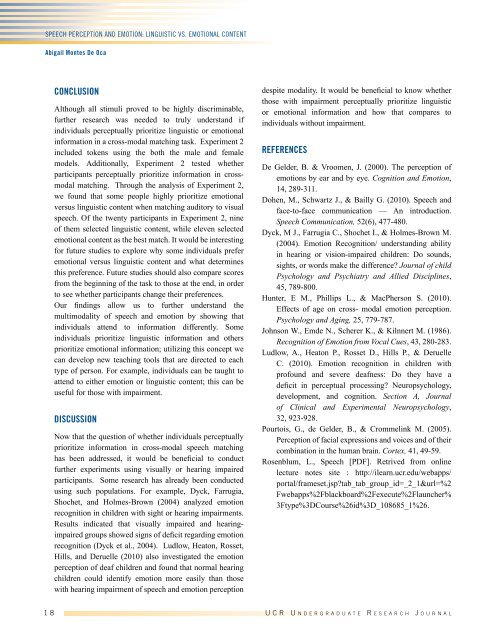Undergraduate Research Journal
Undergraduate Research Journal
Undergraduate Research Journal
Create successful ePaper yourself
Turn your PDF publications into a flip-book with our unique Google optimized e-Paper software.
Speech Perception and Emotion: Linguistic vs. Emotional Content<br />
Abigail Montes De Oca<br />
CONCLUSION<br />
Although all stimuli proved to be highly discriminable,<br />
further research was needed to truly understand if<br />
individuals perceptually prioritize linguistic or emotional<br />
information in a cross-modal matching task. Experiment 2<br />
included tokens using the both the male and female<br />
models. Additionally, Experiment 2 tested whether<br />
participants perceptually prioritize information in crossmodal<br />
matching. Through the analysis of Experiment 2,<br />
we found that some people highly prioritize emotional<br />
versus linguistic content when matching auditory to visual<br />
speech. Of the twenty participants in Experiment 2, nine<br />
of them selected linguistic content, while eleven selected<br />
emotional content as the best match. It would be interesting<br />
for future studies to explore why some individuals prefer<br />
emotional versus linguistic content and what determines<br />
this preference. Future studies should also compare scores<br />
from the beginning of the task to those at the end, in order<br />
to see whether participants change their preferences.<br />
Our findings allow us to further understand the<br />
multimodality of speech and emotion by showing that<br />
individuals attend to information differently. Some<br />
individuals prioritize linguistic information and others<br />
prioritize emotional information; utilizing this concept we<br />
can develop new teaching tools that are directed to each<br />
type of person. For example, individuals can be taught to<br />
attend to either emotion or linguistic content; this can be<br />
useful for those with impairment.<br />
Discussion<br />
Now that the question of whether individuals perceptually<br />
prioritize information in cross-modal speech matching<br />
has been addressed, it would be beneficial to conduct<br />
further experiments using visually or hearing impaired<br />
participants. Some research has already been conducted<br />
using such populations. For example, Dyck, Farrugia,<br />
Shochet, and Holmes-Brown (2004) analyzed emotion<br />
recognition in children with sight or hearing impairments.<br />
Results indicated that visually impaired and hearingimpaired<br />
groups showed signs of deficit regarding emotion<br />
recognition (Dyck et al., 2004). Ludlow, Heaton, Rosset,<br />
Hills, and Deruelle (2010) also investigated the emotion<br />
perception of deaf children and found that normal hearing<br />
children could identify emotion more easily than those<br />
with hearing impairment of speech and emotion perception<br />
despite modality. It would be beneficial to know whether<br />
those with impairment perceptually prioritize linguistic<br />
or emotional information and how that compares to<br />
individuals without impairment.<br />
REFERENCES<br />
De Gelder, B. & Vroomen, J. (2000). The perception of<br />
emotions by ear and by eye. Cognition and Emotion,<br />
14, 289-311.<br />
Dohen, M., Schwartz J., & Bailly G. (2010). Speech and<br />
face-to-face communication — An introduction.<br />
Speech Communication, 52(6), 477-480.<br />
Dyck, M J., Farrugia C., Shochet I., & Holmes-Brown M.<br />
(2004). Emotion Recognition/ understanding ability<br />
in hearing or vision-impaired children: Do sounds,<br />
sights, or words make the difference? <strong>Journal</strong> of child<br />
Psychology and Psychiatry and Allied Disciplines,<br />
45, 789-800.<br />
Hunter, E M., Phillips L., & MacPherson S. (2010).<br />
Effects of age on cross- modal emotion perception.<br />
Psychology and Aging, 25, 779-787.<br />
Johnson W., Emde N., Scherer K., & Kilnnert M. (1986).<br />
Recognition of Emotion from Vocal Cues, 43, 280-283.<br />
Ludlow, A., Heaton P., Rosset D., Hills P., & Deruelle<br />
C. (2010). Emotion recognition in children with<br />
profound and severe deafness: Do they have a<br />
deficit in perceptual processing? Neuropsychology,<br />
development, and cognition. Section A, <strong>Journal</strong><br />
of Clinical and Experimental Neuropsychology,<br />
32, 923-928.<br />
Pourtois, G., de Gelder, B., & Crommelink M. (2005).<br />
Perception of facial expressions and voices and of their<br />
combination in the human brain. Cortex, 41, 49-59.<br />
Rosenblum, L., Speech [PDF]. Retrived from online<br />
lecture notes site : http://ilearn.ucr.edu/webapps/<br />
portal/frameset.jsp?tab_tab_group_id=_2_1&url=%2<br />
Fwebapps%2Fblackboard%2Fexecute%2Flauncher%<br />
3Ftype%3DCourse%26id%3D_108685_1%26.<br />
1 8 U C R U n d e r g r a d u a t e R e s e a r c h J o u r n a l














